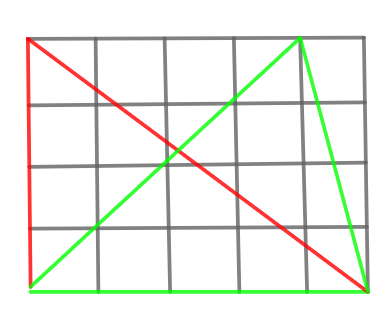
Madhu has divided the rectangle given into \[2\] triangles. The red triangle is half of the big rectangle. Area of the big rectangle is \[20\] square cm. So the area of the red triangle is _____ square cm.


Answer
398.1k+ views
Hint: In order to find the area of the red triangle from the big rectangle whose area is \[20\] square cm, we can either count and the number of boxes the red triangle covers in a proper method i.e. counting the fully occupies boxes first, then the boxes that are quarterly covered and the half boxes that are covered and then the partly covered boxes. Sum of all these boxes gives us the area of the required area. We can solve it logically in the following way.
Complete step by step answer:
Now let us briefly discuss the area of figures. Area of a figure is nothing but the space occupied by a particular figure. The area of a rectangle can be calculated by \[length\times breadth\] and the area of a triangle can be calculated by \[\dfrac{1}{2}\times base\times height\].
Now let us find the area of the red triangle.
We are given that,
Area of the rectangle is \[20\] square cm.
We are also being told that the red triangle is half of the rectangle, which means that the area of the red triangle will be half of the rectangle.
\[\Rightarrow \dfrac{20}{2}=10\text{square cm}\]
\[\therefore \] The area of red triangle is \[10\text{square cm}\]
Note: We can apply areas in our everyday life in finding out the areas covered by the farm or the building or a thing etc.
This problem can also be solved by counting the boxes.
Upon counting, we can find that,
Number of boxes that are fully covered is \[7\].
Number of boxes that are three quarters covered is \[2\].
Number of boxes that are half filled is \[2\].
We must have a note that half boxes are added up to form whole and the three quarter filled boxes are considered as whole.
Upon adding all of these, we get the area as \[10\text{square cm}\].
Complete step by step answer:
Now let us briefly discuss the area of figures. Area of a figure is nothing but the space occupied by a particular figure. The area of a rectangle can be calculated by \[length\times breadth\] and the area of a triangle can be calculated by \[\dfrac{1}{2}\times base\times height\].
Now let us find the area of the red triangle.
We are given that,
Area of the rectangle is \[20\] square cm.
We are also being told that the red triangle is half of the rectangle, which means that the area of the red triangle will be half of the rectangle.
\[\Rightarrow \dfrac{20}{2}=10\text{square cm}\]
\[\therefore \] The area of red triangle is \[10\text{square cm}\]
Note: We can apply areas in our everyday life in finding out the areas covered by the farm or the building or a thing etc.
This problem can also be solved by counting the boxes.
Upon counting, we can find that,
Number of boxes that are fully covered is \[7\].
Number of boxes that are three quarters covered is \[2\].
Number of boxes that are half filled is \[2\].
We must have a note that half boxes are added up to form whole and the three quarter filled boxes are considered as whole.
Upon adding all of these, we get the area as \[10\text{square cm}\].
Recently Updated Pages
Master Class 9 General Knowledge: Engaging Questions & Answers for Success

Master Class 9 English: Engaging Questions & Answers for Success

Master Class 9 Science: Engaging Questions & Answers for Success

Master Class 9 Social Science: Engaging Questions & Answers for Success

Master Class 9 Maths: Engaging Questions & Answers for Success

Class 9 Question and Answer - Your Ultimate Solutions Guide

Trending doubts
Voters list is known as A Ticket B Nomination form class 9 social science CBSE

The president of the constituent assembly was A Dr class 9 social science CBSE

What are the causes of uneven distribution of population class 9 social science CBSE

Explain Right to Equality

Find the day of the week on 26 January 1950 class 9 maths CBSE

Fill in the blank with the most appropriate option class 9 english CBSE




